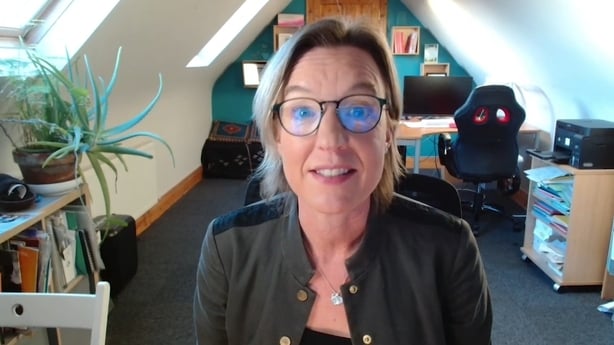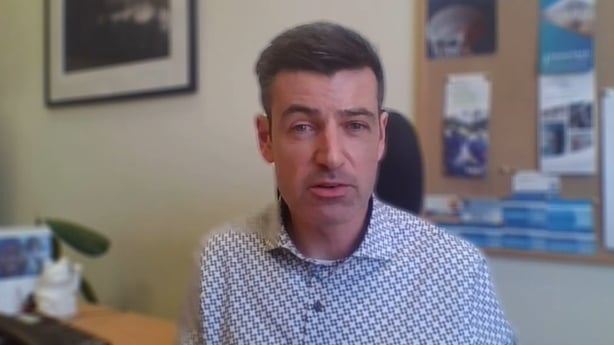Two weeks on from one of the most destructive storms in the history of the State, thousands of people are still in the dark with repair crews working to get the lights back on across the country.
Today in the Dáil, deputies debated what went wrong, pointed the finger of blame and spoke of "lessons learned" from the "bruising experience."
With Met Éireann warning that major weather events like Storm Éowyn are set to become a more frequent occurrence in the years ahead, the question now is what needs to be done to make sure, next time, Ireland is ready.
By the time the last red weather warning for Storm Éowyn had been lifted on 24 January, record-breaking wind gusts of 184km/h had been recorded, causing an estimated €200m in damage and leaving 768,000 electricity customers without power.
No power meant businesses and schools were forced to close, transport links disrupted, and hospitals left relying on emergency generators.
With seven thousand people still without power now, questions are being asked about the country's preparedness to face extreme weather, and whether more could have been done to mitigate the impact of Storm Eowyn.
Some experts, including environmental scientist Dr Tara Shine, believe we should have already been prepared this time round.
"I did an assessment of Ireland's capacity to adapt to climate change back in 2011 and then, we found that we weren't adequately prepared," Dr Shine said.
While Storm Éowyn has not been directly linked to climate change, Met Éireann has warned that such extreme weather events will become more normal as the Earth’s climate changes.
"We have the data, we had the data back then, but we weren't adequately planning, acting, investing or learning at that time." Dr Shine said, "I think Storm Éowyn shows us just how unprepared we are overall as a society for extreme weather events."

Power failure
A major talking point in the last two weeks has been the impact Storm Éowyn has had on our energy infrastructure.
Other storms in recent years have also caused mass power cuts, but not to this level.
In 2017 Storm Ophelia knocked out power from 385,000 premises according to ESB Networks, while Storm Ellen in 2020 caused 194,000 outages – one third of the scale of damage this time around.
It has all triggered the need for what An Taoiseach Micheál Martin has described as "a fundamental rethink in terms of storm resilience."
So why is that rethink needed, and what should it consider?
Geography plays a major role in Ireland’s electricity infrastructure and goes some way to explaining why we are so susceptible to extreme weather.
Around 84% of our electricity network still runs above ground, via 160,000km of cables and 2.4 million fixed poles. This is due to a number of factors including the rate of one-off rural housing and our relatively low population density.
In much of mainland Europe power lines are run underground — a system that’s more resilient to storms. In Sweden and Finland, 40% of their networks run underground despite those countries having lower population density to our own.
They have also had to contend with extreme weather conditions for a lot longer than us.
In the wake of the storm, some have suggested that we need to look at undergrounding the electricity network. Yet experts like Dr Barry Hayes from University College Cork (UCC) say the idea is unviable.
"The cost of putting all of that underground would be prohibitive. It would also be very disruptive. We'd have to reroute a lot of the lines that run across fields and so on and we'd have to dig up all of our roads," Dr Hayes said.
The estimated cost is upwards of €100 billion.
Dr Hayes, an Associate Professor in Power Systems Engineering at UCC, said the focus should instead be on improving the infrastructure we already have in place, some of which is over 50 years old.
"There are things that we can do to improve our resilience to storms. A lot of the components that make up our distribution system have been in service since the 1970s or earlier. There are plans in place to start weather hardening some of our existing overhead lines," Dr Hayes said.
As well as improving what we already have, Dr Hayes said people utilising alternative energy sources to respond to power outages will also become more common in the future.
"I was encouraged to see a lot of electric vehicle owners were able to use their electric vehicle batteries to charge some of their smaller critical loads. Over time, we'll also see more people installing home batteries as a source of local backup generation," Dr Hayes added.

Telecoms disruption
Of significant concern to many who have felt the impact of Storm Eowyn was the damage to telecommunications countrywide.
Éowyn caused the biggest telecoms outage in the history of the State according to ComReg, the Commission for Communications Regulation. Over one million telecoms users were, at one point, left with no phone coverage or broadband at all.
Internet connection speeds collapsed by 78% nationally on the day of the storm, as one thousand key sites were taken offline, according to analysis by Ookla, a widely-used platform for measuring connection speeds and assessing network performance.
"We are remarkably dependent on telecommunications these days," said Deryck Fay, an expert on the telecoms industry and author of 'Connecting a Nation: The story of telecommunications in Ireland.’
"It's part of the national infrastructure. Everybody has a mobile phone. Older people would be big users of WhatsApp for example. Simple little things like keeping in touch with family. That's important," Mr Fay said.

The telecommunications network is powered by the electricity grid, and the Government said on Wednesday that a Winter 2025 Grid Resilience Plan is to be developed within one month.
It will be aimed at enhancing the energy grid in the most vulnerable locations for the upcoming winter.
However, all these enhancements will cost money.
Storm Darwin in 2014 cost the country about €111 million, and already estimates of up to €200 million are being predicted for Éowyn.
These storms aren’t going away and as Dr Tara Shine says, the time for preparing for storms likely to hit us in the next decade is now.
"We really need to look at our critical infrastructure and invest. When we do the tally on how much Storm Éowyn will have cost us, go back 10 years, perhaps we should have invested in the preparedness."





